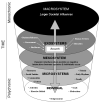Understanding systems and rhythms for minority recruitment in intervention research
- PMID: 19885838
- PMCID: PMC3412589
- DOI: 10.1002/nur.20355
Understanding systems and rhythms for minority recruitment in intervention research
Abstract
We describe one approach for recruitment and retention of minority individuals in intervention research using a systematic environmental perspective based on Bronfenbrenner's ecological systems (BES) model and the construct of temporality. An exemplar in a physical activity intervention study with low-income and primarily African American women is presented. The exemplar illustrates application of BES and temporality to enhance recruitment and retention in research focused on understanding and accommodating environmental influences. Using this theory based approach resulted in successful recruitment and a high level of participant retention.
Figures
References
-
- Adams-Campbell LL, Ahaghotu C, Gaskins M, Dawkins F, Smoot, Polk O, et al. Enrollment of African Americans onto clinical treatment trials: Study design barriers. Journal of Clinical Oncology. 2004;22(4):730–734. - PubMed
-
- Albright CL, Pruit L, Castro C, Gonzalez A, Woo S, King AC. Modifying physical activity in a multiethnic sample of low-income women: One year results from the IMPACT (Increasing Motivation for Physical ACTivity) project. Annals of Behavioral Medicine. 2005;30(3):191–200. - PubMed
-
- Bergmann W. The problem of time in sociology: An overview of the literature on the state of theory and research on the “sociology of time”, 1900-82. Time Society. 1992;1(1):81–134.
-
- Bronfenbrenner U. The ecology of human development: Experiments by nature and design. Harvard University Press; Cambridge, MA: 1979.
-
- Bronfenbrenner U. Ecological systems theory. In: Vasta R, editor. Annals of child development. Vol. 6. JAI Press; Greenwich, CT: 1989. pp. 187–249.
Publication types
MeSH terms
Grants and funding
LinkOut - more resources
Full Text Sources

